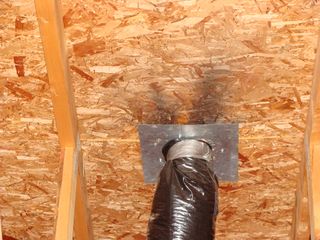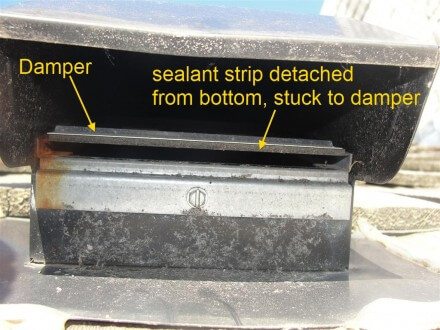 If you have a home that was roofed before 2006, there is a good chance that one or more of your bathroom exhaust fans aren’t doing their job properly if they’re vented through the roof.
If you have a home that was roofed before 2006, there is a good chance that one or more of your bathroom exhaust fans aren’t doing their job properly if they’re vented through the roof.
I start every home inspection by giving myself a quick tour of the inside of the house to get an idea of what I need to be looking for while inspecting the exterior. While doing my brief initial walk-thru of the interior, I also turn on everything that removes air from the house, such as bathroom exhaust fans, kitchen exhaust fans, and clothes dryers. I do this to create negative pressure in the house, so I can later make sure that all of the fuel burning appliances still draft properly, and to make sure that all of the fans exhaust the way they’re supposed to.
As I turn the fans on in the home, I make a mental note of how many fans I’ve turned on, and I account for each exhaust while inspecting the exterior. I’ve caught a ridiculous amount of bathroom exhaust fans there were vented in to attics or finished floor / ceiling spaces by doing this. This is also a way for me to check to see that the fans are actually exhausting air, not just making a lot of noise.
I check the operation of bath fans by just putting my hand at the exhaust and making sure air is blowing out – after first checking for wasp nests, of course. About one-third of the fans that are supposed to be exhausting through the roof are exhausting to a cap with a backdraft damper that is stuck closed, which causes a good portion of the warm, moist air to exhaust in to the attic space (pictured above). One of the more popular roof caps in our area is made by Broan, so I’ll be talking about their specific roof cap.
Most roof caps for bath fan exhausts have a light aluminum backdraft damper which rests on a sealant strip, which is basically a foam piece of weatherstripping. This sealant strip is installed to keep cold air from coming in, and according to a Broan customer service rep, it also “helps to prevent unbearable metal on metal chatter.” Unfortunately, when the sealant strip gets hot from the sun beating on the cap all day, it gets sticky. Eventually, the damper gets completely stuck to the sealant strip, which prevents the damper from opening. This is what causes the black staining in the attic that you see pictured above.
The photo below shows a close-up view of a roof cap – if you click on the photo, you can see a blow-up. In this particular photo, the sealant strip was so badly stuck to the damper that when I pried that damper open, the sealant strip detached from the bottom and actually stayed attached to the damper.
When I find this defect, I usually take my awl and pry the damper open, which allows the damper to open and close freely again… until the next hot day. Broan received so many complaints about these dampers getting stuck that they finally changed the material that was used for the sealant strip in 2006. Now the sealant strips are made of polyester, and they don’t get stuck any more. If you own a house with older roof caps, you can order a replacement damper and sealant strip from Broan by calling 800-558-1711, part # 97017696. Click here for damper replacement instructions – they’re listed under the Maintenance section.
Special thanks to Judi Weber at Broan for contributing information to help write this.
Post Update 7/22/14: Here’s a nice video clip from Milind. This clip shows him prying the stuck damper loose with his awl.
Reuben Saltzman, Structure Tech Home Inspections – Email – Maple Grove Home Inspector

